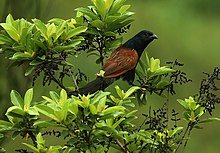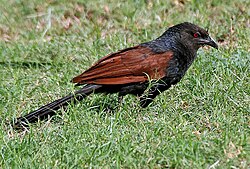Coucal
| Coucals | |
|---|---|

| |
| Lesser coucal (Centropus bengalensis) | |
| Scientific classification | |
| Kingdom: | Animalia |
| Phylum: | Chordata |
| Class: | Aves |
| Order: | Cuculiformes |
| Family: | Cuculidae Horsfield, 1823 |
| Genus: | Centropus Illiger, 1811 |
| Type species | |
| Centropus senegalensis L. (1766)
| |
| Species | |
|
About 30, see text | |

A coucal is one of about 30 species of birds in the cuckoo family. All of them belong in the subfamily Centropodinae and the genus Centropus. Unlike many Old World cuckoos, coucals are not brood parasites, though they do have their own reproductive peculiarity: all members of the genus are (to varying degrees) sex-role reversed, so that the smaller male provides most of the parental care. At least one coucal species, the black coucal, is polyandrous.[1] Some species (Centropus phasianinus) have the male investing more in incubation and parental care.[2] DNA evidence has indicated that they should be raised to family status, as Centropodidae.[3]
Description[]
Many coucals have a long claw on their hind toe (hallux). The genus name from Greek kentron, a spike and pous for foot describe this hallux claw. The feet have minute spurs and this is responsible for the German term for coucals Sporenkuckucke. The common name is perhaps derived from the French coucou and alouette (for the long lark like claw).[4] (Cuvier, in Newton 1896) The length of the claw can be about 68-76% of the tarsus length in the African black coucal C. grillii and lesser coucal C. bengalensis. Only the short-toed coucal C. rectunguis is an exception with the hallux claw of only 23% of the tarsus length. Thread like feather structures (elongated sheaths of the growing feathers that are sometimes termed trichoptiles[5][6]) are found on the head and neck of hatchlings and can be as long as 20mm. Nestlings can look spiny.[7] Many are opportunistic predators, Centropus phasianus is known to attack birds caught in mist nets[8] while white-browed coucals Centropus superciliosus are attracted to smoke from grass fires where they forage for insects and small mammals escaping from the fire.[7]: 17
Coucals generally make nests inside dense vegetation and they usually have the top covered but some species have the top open. Pheasant coucal Centropus phasianinus, greater coucal C. sinensis and Madagascar coucal C. toulou sometimes build an open nest while some species always build open nests (the bay coucal C. celebensis)[7]: 120
Some coucal species have been seen to fly while carrying their young.[9]
Species[]
- Andaman coucal or brown coucal, Centropus andamanensis
- Gabon coucal, Centropus anselli
- White-necked coucal or pied coucal, Centropus ateralbus
- Lesser coucal, Centropus bengalensis
- Black-billed coucal or lesser black coucal, Centropus bernsteini
- Kai coucal, Centropis spilopterus
- Green-billed coucal, Centropus chlororhynchos
- Bay coucal, Centropus celebensis
- Biak coucal, Centropus chalybeus
- Coppery-tailed coucal, Centropus cupreicaudus
- Goliath coucal, Centropus goliath
- Black coucal, Centropus grillii
- Black-throated coucal, Centropus leucogaster
- Black-faced coucal, Centropus melanops
- Ivory-billed coucal or greater black coucal, Centropus menbeki
- Buff-headed coucal, Centropus milo
- Blue-headed coucal, Centropus monachus
- Sunda coucal, Centropus nigrorufus
- Pheasant coucal, Centropus phasianinus
- Timor pheasant coucal or Timor coucal, Centropus phasianinus mui - might be a full species Centropus mui (long known only by the holotype (a female) collected in 1974 but apparently rediscovered in the early 2000s)[10]
- Short-toed coucal, Centropus rectunguis
- Senegal coucal, Centropus senegalensis
- Greater coucal, Centropus sinensis
- Centropus parroti (?[11])
- Black-hooded coucal, Centropus steerii
- White-browed coucal, Centropus superciliosus
- Burchell's coucal, Centropus burchelli
- Malagasy coucal or Madagascar coucal, Centropus toulou
- Assumption Island coucal, Centropus toulou assumptionis - doubtfully distinct; extinct (c. 1920s)
- Rufous coucal, Centropus unirufus
- Violaceous coucal, Centropus violaceus
- Philippine coucal, Centropus viridis
A fossil species, Centropus colossus, is known from the Quaternary-aged Fossil Cave, Tantanoola, South Australia.
References[]
| Wikimedia Commons has media related to Centropus. |
- ^ Andersson, Malte (1995). "Evolution of reversed sex roles, sexual size dimorphism, and mating system in coucals (Centropodidae, Aves)". Biol. J. Linn. Soc. 54 (2): 173–181. doi:10.1111/j.1095-8312.1995.tb01030.x. Archived from the original (Abstract) on 2013-01-05.
- ^ Maurer, G. (2008). "Who Cares? Males Provide Most Parental Care in a Monogamous Nesting Cuckoo". Ethology. 114 (6): 540–547. doi:10.1111/j.1439-0310.2008.01498.x.
- ^ "Mystery bird: Blue-headed coucal, Centropus monachus | @GrrlScientist". The Guardian. 14 November 2011. Retrieved 12 January 2021.
- ^ Newton, A. (1896). A dictionary of birds. London: Adam and Charles Black.
- ^ Shelford, R (1900). "On the pterylosis of the embryos and nestlings of Centropus sinensis". Ibis. 6: 654–667. doi:10.1111/j.1474-919x.1900.tb00763.x.
- ^ Hindwood, KA (1942). "Nestling Coucal" (PDF). The Emu. 42 (1): 52. doi:10.1071/MU942050c.
- ^ a b c Payne, R.B. (2005). The Cuckoos. Oxford University Press. ISBN 0-19-850213-3.
- ^ Hicks, R.K.; Restall, R. (1992). "Pheasant coucal Centropus phasianus attacking birds caught in a mist net". Muruk. 5: 143.
- ^ Bell, H.L. (1984). "Carrying of young in flight by Coucals Centropus spp". Australian Bird Watcher. 10: 171.
- ^ Trainor, Colin; et al. (2008). "Birds, birding and conservation in Timor-Leste". BirdingASIA. 9: 16–45.
- ^ Rasmussen, P.C.; Anderton, J.C. (2005). Birds of South Asia. The Ripley Guide. Smithsonian Institution & Lynx Editions.
- Centropus